I had the privilege of giving this talk at the National Women’s Leadership Consortium’s Virtual Symposium on October 30, 2020.
Good Afternoon! I want to thank Valerie Truesdale for inviting me to join all of you today. It is a great honor to be here.
When we first started talking about this event back in January, Valerie had asked if I would speak to you about the role of Artificial Intelligence in education. That almost feels like a quaint topic right now, and probably one that nobody really cares to hear about. Of course, we also thought that this event would be in person in DC, but we obviously had no idea what 2020 was about to unleash. So here we are…
I realize that today is not only a Friday, but also the Friday before Halloween – which under normal circumstances would be absolute mayhem in any school. Under the current circumstances, well I have no idea. Regardless, before we go any further, I would like to do a quick breathing exercise. Hopefully, you will play along on your screen. On the count of three, I would like for you to take a really deep breath and hold it. 1-2-3… now exhale… Which one was better? Inhaling or exhaling?
We’re going to do this one more time but instead of holding your breath in, you’re going to hold it out with your exhale. 1-2-3 in and out…… Now which one is better? Exhaling or inhaling?
I realize that this is a pretty extreme example. In order to live, we need to inhale AND exhale. As Jane Kise explains in her book, Unleashing the Power of Positive Differences, breathing is an example of a polarity.
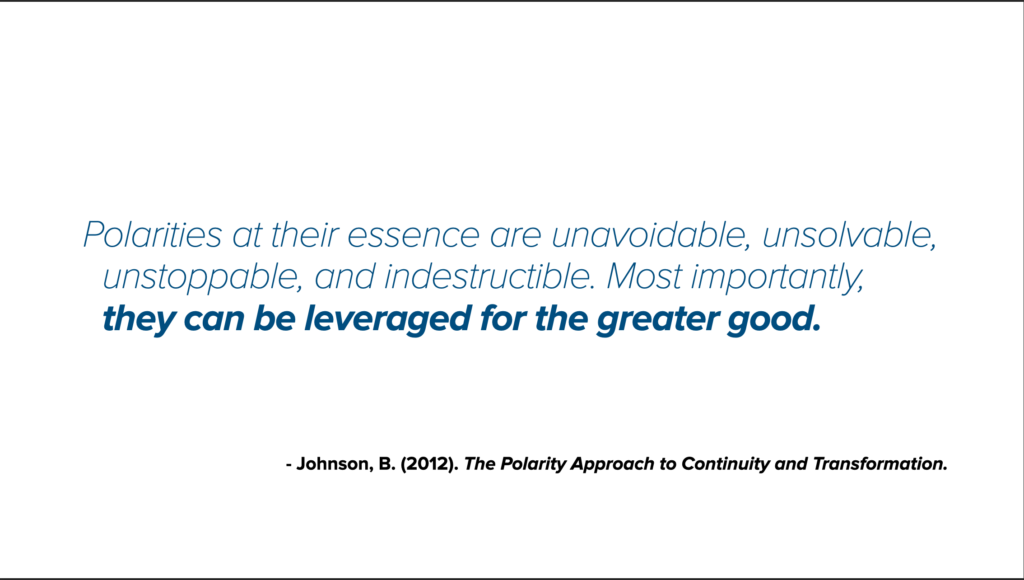
Much like breathing, a polarity isn’t something to solve, it’s something to leverage. We can’t breathe by only inhaling or only exhaling. We need the best of both. I know that this school year feels like an avalanche of competing problems to solve, challenges to tackle, and issues to address. For the next 25ish minutes, though, I want to see if we can begin to find a way to think about these different things not as polar opposites but as poles to keep in balance.
Even though it feels like the end of April, believe it or not, it’s only the end of October. I would like for you to think about the next 7 months which should get us to the end of May. In your role within your school or district, what is the greater purpose that you hope to achieve? On the other hand, what is anchoring you and holding you back from gaining that greater purpose? What is your deeper fear – that thing lurking beneath the surface that prevents you from going for what you know you want to achieve? Finally, how are these two things related? What are the paradigms forcing us to choose between achieving our greater purpose and just quelling our deeper fear? What are the systems or structures forcing us to “perform school” instead of addressing these fears or working to achieve these greater goals?
As a researcher, I do a lot of reading and a lot of listening. Let’s think about all of the things that have emerged in the last few months as either-ors that keep getting in the way. In person or online, video on or video off, taking attendance or not, using grades and assessments or moving to a mastery/competency system, requiring students to meet hard deadlines or allowing for flexible tasks.
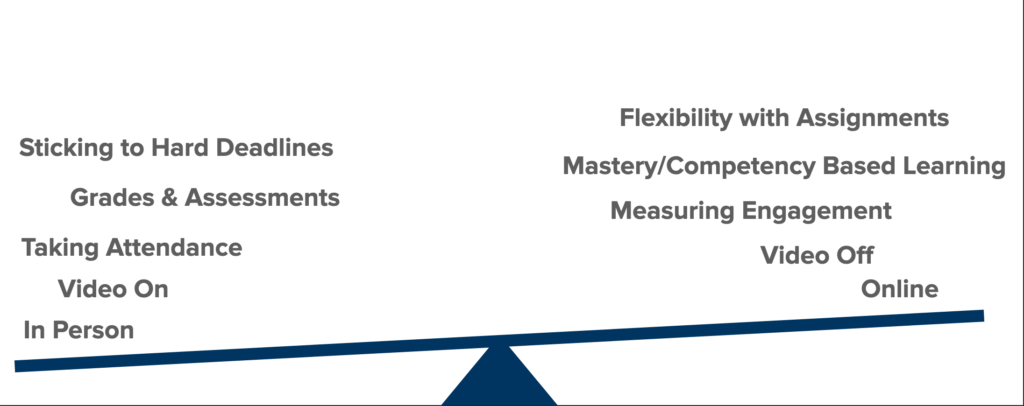
And yet… Can teachers have class engagement or conversation without requiring audio or video? Can teachers measure student learning without punishing them for circumstances outside of their control? Can you, as leaders, maintain accountability and control while creating a community based on compassion and care?
Let’s go back to our greater purpose. What do we really hope to achieve? There has been plenty of talk about getting back to “normal” but what if “normal” didn’t work for all kids? Recently, I’ve ready a few articles about students who are thriving online. For them, school had been a place of trauma – whether because of their race, their gender identity, their socioeconomic situation, their learning needs, or maybe the absolute angst of being a teen.
I’ll ask you this. Is our greater purpose a return to “normal” or an opportunity for improvement? This brings us back to the issue of paradigms, to the competing systems, and to the bigger question: how can we find balance?
Polarity mapping gives us a strategy to tame complexity. To see how to take seemingly competing priorities and convert them into a path towards improvement. Besides, we won’t know how to get where we’re going, if we don’t have a map.
A polarity map works like a combination lock. You have to do it in order, or it won’t unlock. I want you to start by thinking about what you wrote down as your greater purpose and deeper fear. Based on that, what do you think are your poles – the either/ors? Remember, a polarity isn’t a problem to solve or a side to choose. It’s not inhaling or exhaling. It’s an interdependence to manage.
As a warning, this process takes you on a bit of a psychological roller-coaster. Internally, you are really going to be rooting for either “The Either” or “The Or.” However, working through this exercise is going to force you to check your own bias and consider the positives and negatives of both sides.
As I said, I read and watch and listen a lot. Across the country, I have heard great leaders like yourselves tell me in one way or another that their greater purpose is to make sure that ALL students feel supported. At the same time, there is the presence of a deep seeded fear of potentially failing kids. And yet, the polarity that seems to be driving so many conversations is the tension between maintaining compliance and control with exhibiting compassion and care.
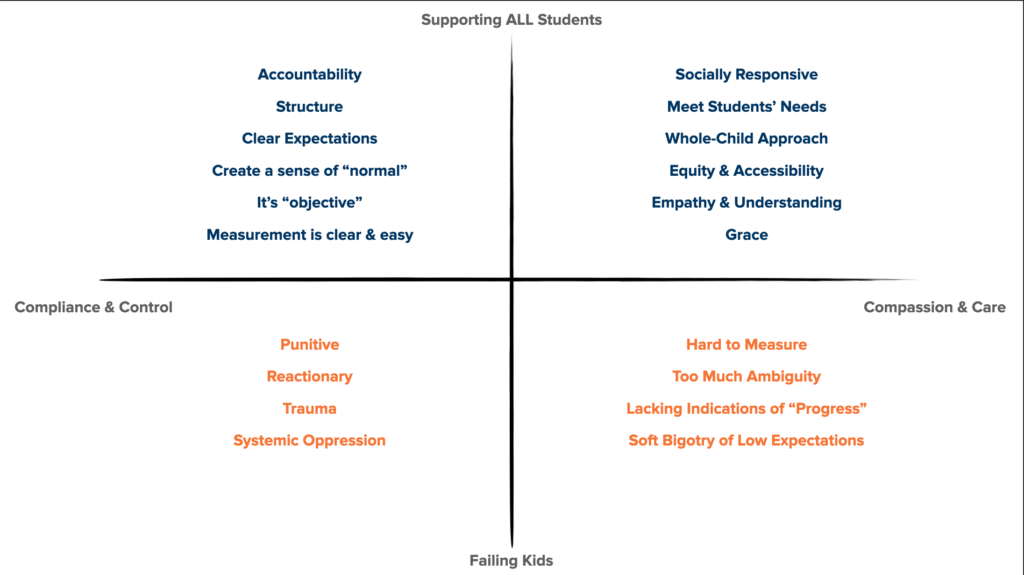
So let’s take a look at the positives. There’s nothing wrong with the positives on both sides. The issue is when we swing too far to one side or the other.
- Student marked absent for not turning on a camera even though it doesn’t work
- Student penalized for not having a quiet place to answer questions orally when they live in a 1-bedroom apartment with multiple siblings
- Student not allowed to turn in an assignment late after the internet didn’t work
At the same time…
- Students lack opportunity when they aren’t provided with challenging content in the name of “equity”
- Schools or districts announce that they are not doing any grading and it gets translated into teachers not providing any feedback or progress monitoring
- Expectations are set too low – especially for students of color or those in underserved communities. “Those kids” won’t be able to do ____
Let’s look at this more objectively using recent data from the Center on Reinventing Public Education (CRPE). Nationally, there has been a swing towards accountability and measures of control. In and of itself, this is not an issue. But what happens when we have these measures without compassion and care?
Back in September, a professor whom I follow on Twitter posted that internet went down in her entire town during remote learning. When it came back on, her child emailed her two teachers to apologize for missing live instruction. One responded that it was not problem, that the recording had been posted to Google Classroom, and to please complete the activity. The other replied with, “I marked you absent.” We can ask for compliance and still demonstrate care.
We can also care too much. Or show care in ways that do not ultimately benefit our students. In an analysis of data collected from last spring, CRPE determined that 2/3rds of the surveyed districts indicated that they set low expectations for sustaining instruction. Even though existing research indicates that low expectations most harm students who already face the greatest challenges: those from under-resourced communities, those who have learning differences, and those who may not speak English at home.
Additionally, only 42% of the surveyed districts expected teachers to assign, collect, and grade student work. Not only did this set a negative precedent for students but it also removed opportunities for them to grown and learn. Again, this was especially prevalent for students from underserved and rural communities as those districts indicated lower expectations in terms of attendance, engagement, and especially live instruction. When expectations are too low in the name of compassion and care, we risk losing our most vulnerable kids.
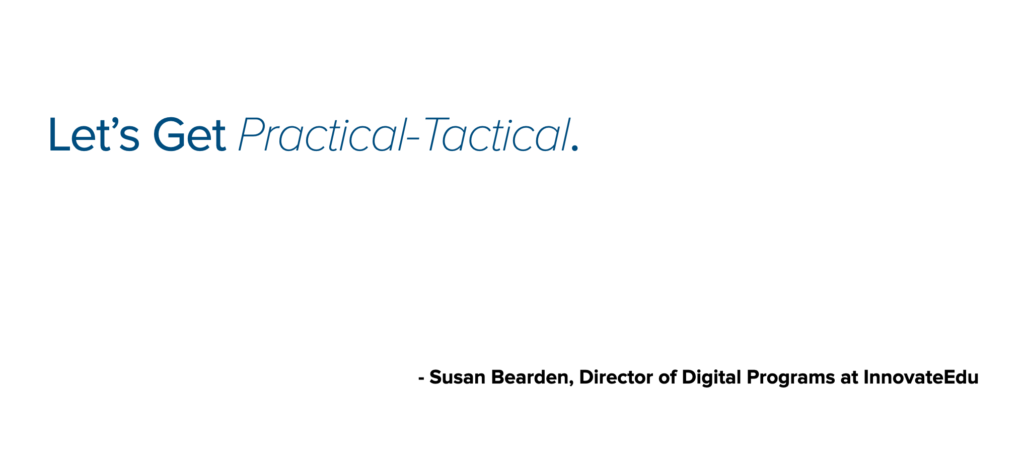
Let’s face it, no one needs an academic focused on survey data in the middle of a global pandemic, a contentious election, civil unrest, and an economic downturn. Now that we can see the problem, what can we actually DO about it. To quote my colleague Susan Bearden, let’s get practical-tactical.
While lots of big research organizations have started to compile mounds of evidence about what we can see, there’s very little guidance for what leaders like yourselves should do. However, Lindsay Unified School District in California wanted to find out.
Admittedly, Lindsay is a bit of a unicorn. A relatively small, rural district in central California, they serve a low socioeconomic, largely Hispanic/Latino community. Over a decade ago, they adopted a personalized learning model that focuses on equity and lifelong learning. Beginning in 2015, they started building out a community wifi program, provided devices to every student, and adopted a number of online platforms for content delivery. When COVID closed their doors last spring, they had all of the infrastructure in place to achieve their greater purpose – to provide the best possible learning experience for every student.
When we surveyed the teachers to better understand the remote learning experience, we learned 5 critical leadership lessons.
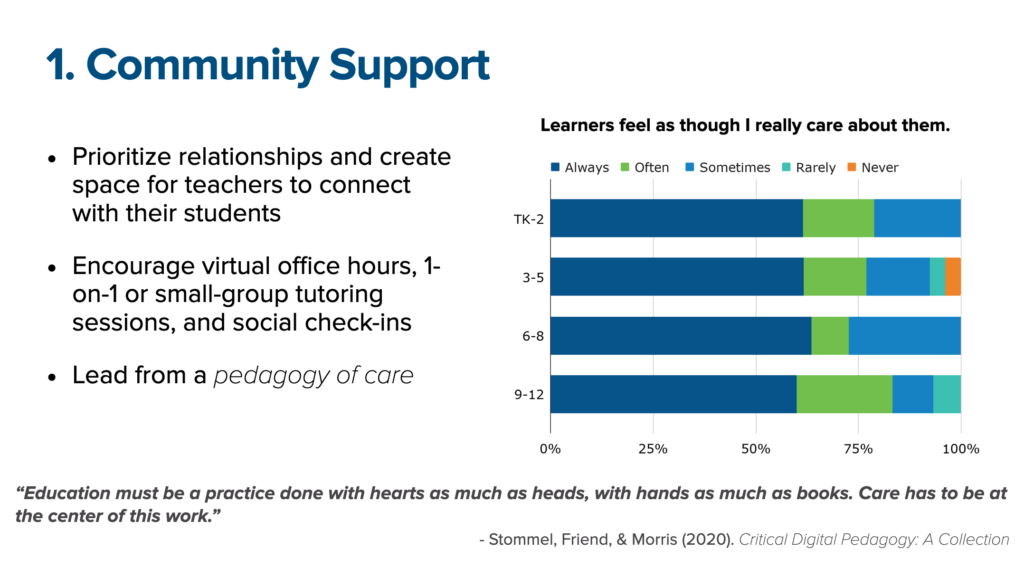
Prior to the COVID closure, district leaders had communicated that maintaining a sense of community would be a top a priority. As a result, the data revealed that educators in Lindsay overwhelmingly believed that their learners felt safe, cared for, and supported. This shows us that the idea of care needs to come from leadership. There’s no one way to build community – especially in an online space – but teachers do need to know that it is an expectation.
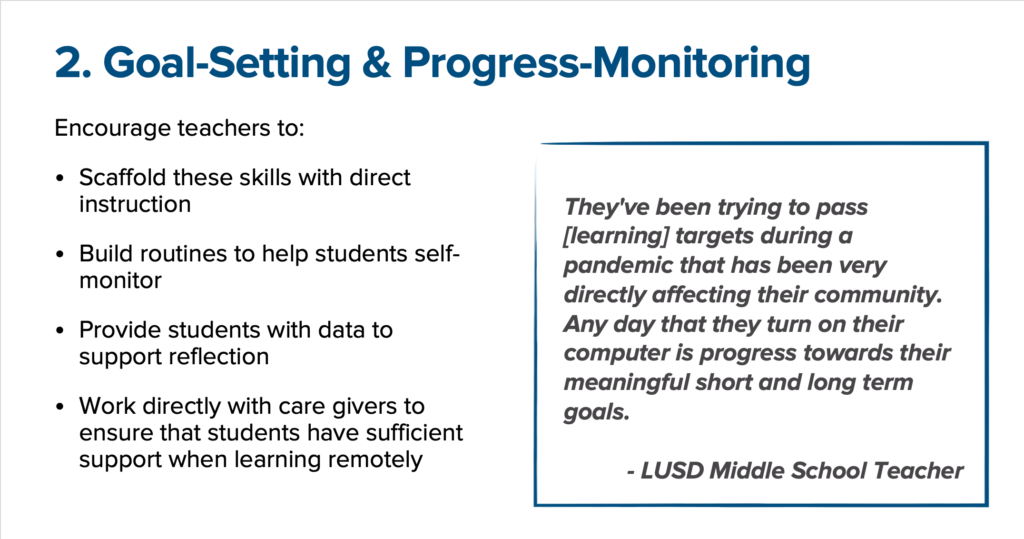
A big area of concern in Lindsay was the tension between setting and attaining goals as well as independently monitoring progress. The teachers commented on a number of different strategies that they had to design and build into their routines to help their students take more ownership and agency within a remote environment. At the same time, as one middle school teacher commented, just logging into class needs to be considered progress. Yes, there needs to be accountability and control. At the same time, there needs to be understanding, empathy, and support.
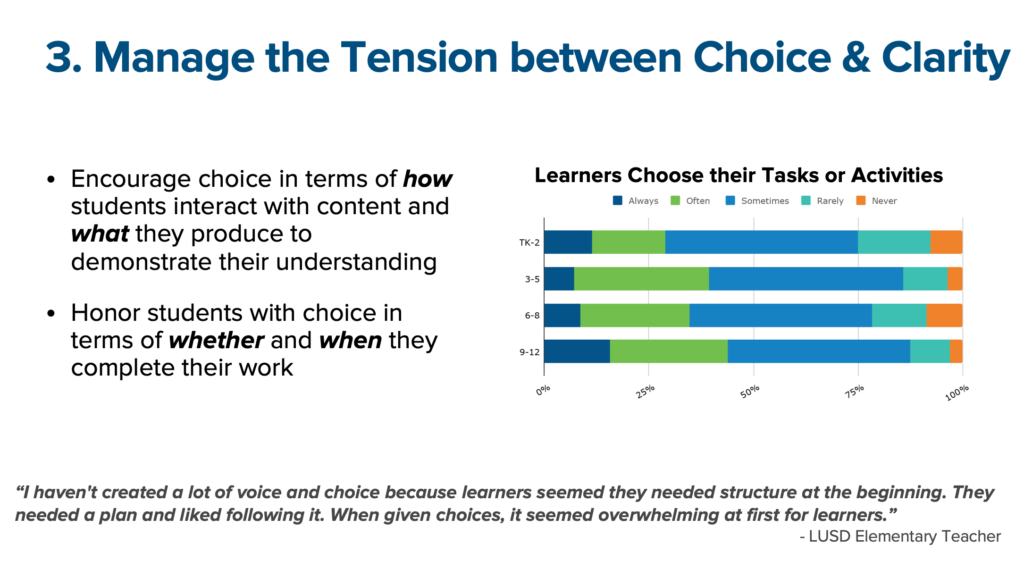
At the heart of Lindsay’s personalized learning model lies the idea of voice and choice. However, when asked how often learners chose their activities or tasks during remote instruction, educators noted varying frequencies depending on the age of their students. At the same time, when asked how they gave students choice or allowed for more agency, a high percentage of teachers explained that remote learning required more structured freedom. They used “choice boards” to manage ambiguity and often gave options based on timing or pace instead of topic or output. Especially with older students – many of who had to work or care for younger siblings while also keeping up with school – teachers honored them by allowing choice about when or whether to do the work.
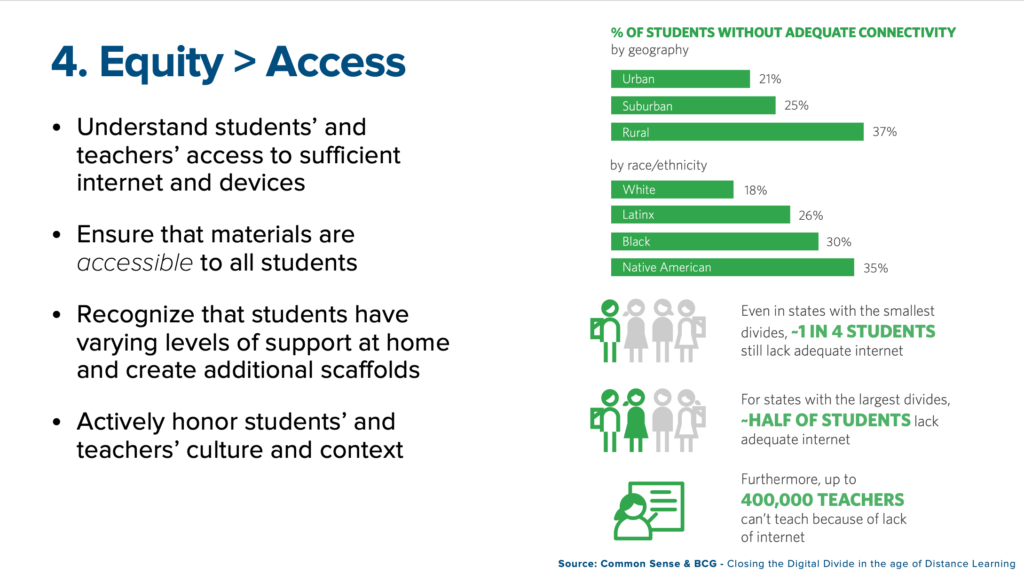
As I mentioned, Lindsay is a bit of a unicorn. They had already ensured that every student had a device as well as internet access before the pandemic even started. Nationally, it is a very different story. Recent data from Common Sense and Boston Consulting Group found that 15-16 million students lacked sufficient access to the internet to even participate in remote or hybrid learning. Of that group, 9 million did not have a laptop, tablet, or computer. It is also critical to note that approximately 400,000 teachers also did not have access and yet were expected to teach online.
Beyond basic access, as leaders, are teachers ensuring that materials are accessible for all learners? Meaning, do videos have captions? Can content be read with a screen reader? Do students have directions as text and audio?
Let’s say that we solve those challenges, how about recognizing that students have varying levels of support at home. Are teachers actively scheduling times to meet with parents or caregivers to bring them into the process? For districts with a large percentage of families who do not speak English at home, are resources and materials offered in multiple languages? Are translators available?
Finally, at this crucial moment, can you make space to deeply consider whether the learning experiences honor students’ and teachers’ culture and context. As leaders, before approving an app or program, a piece of content, or a revised curriculum, take a pause to consider how – or whether – it embraces a multicultural perspective. Ask yourselves whether your students see themselves represented in what they are learning.
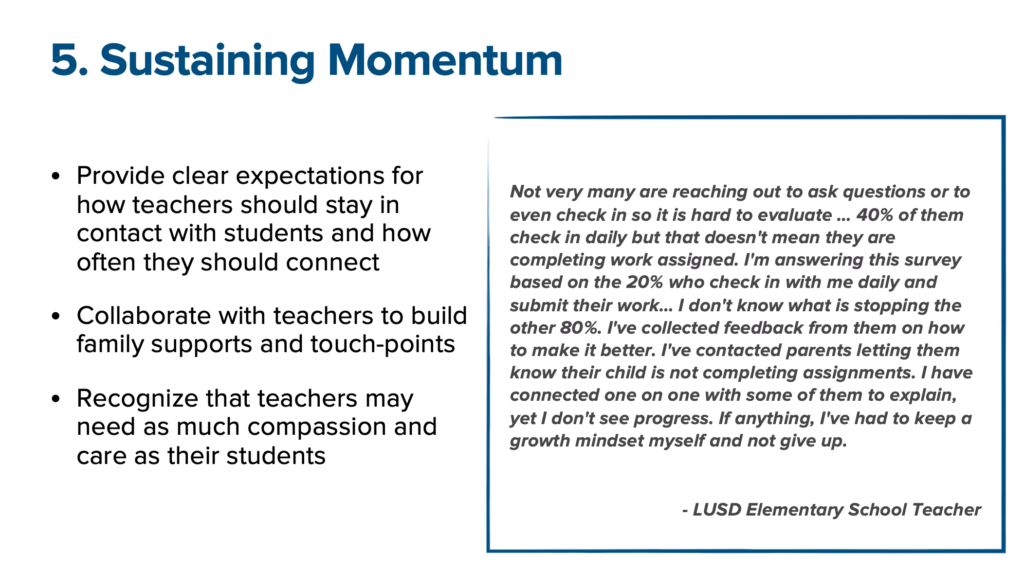
Believe it or not, but it’s only the end of October. Last spring, educators in Lindsay saw enthusiasm wane towards the end of the year. Students missed their friends and their teachers. They did not have the same supports at home as at school. Many disappeared – either to work or to care for others.
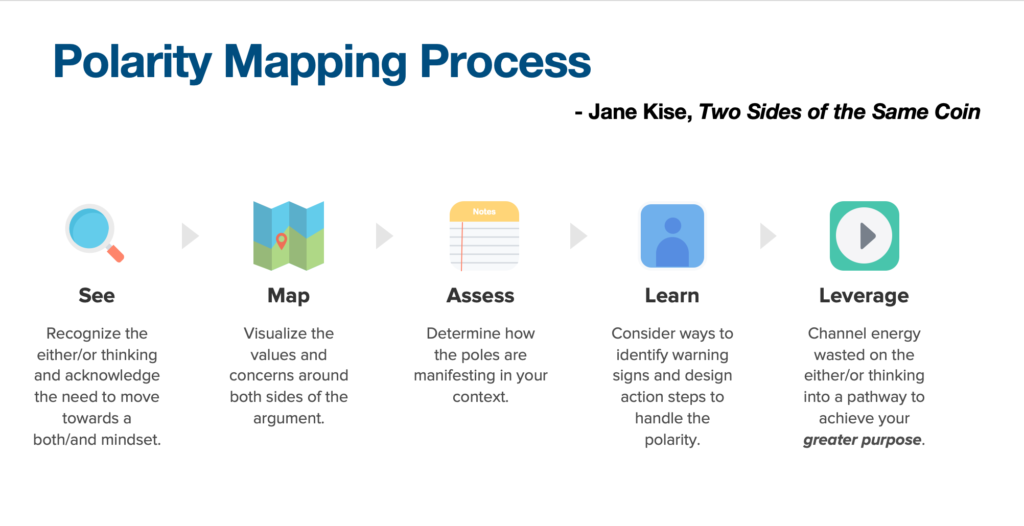
I want to review our mapping process. First, we have to See. We need to recognize the either/or thinking. Then take the time to build your Map – make sure you really pay attention to the greater purpose and deeper fears that influence each side of the argument. Then try to objectively Assess your two poles. What are the positives and negatives of both? Think through how the different extremes might be playing out in your context so that you can Learn from it. Remember, a polarity is an opportunity for improvement. Finally, Leverage it. The ultimate goal is to create balance. To see the system so that you can ultimately get to your greatest hope.
You have an unprecedented opportunity this year. As school and district leaders, you have the chance to define the new “normal.” The challenge is how you will balance the challenges of the past with the promise of the future to create a system that truly benefits all of our students.
Thank you so much for this opportunity and for having me today.